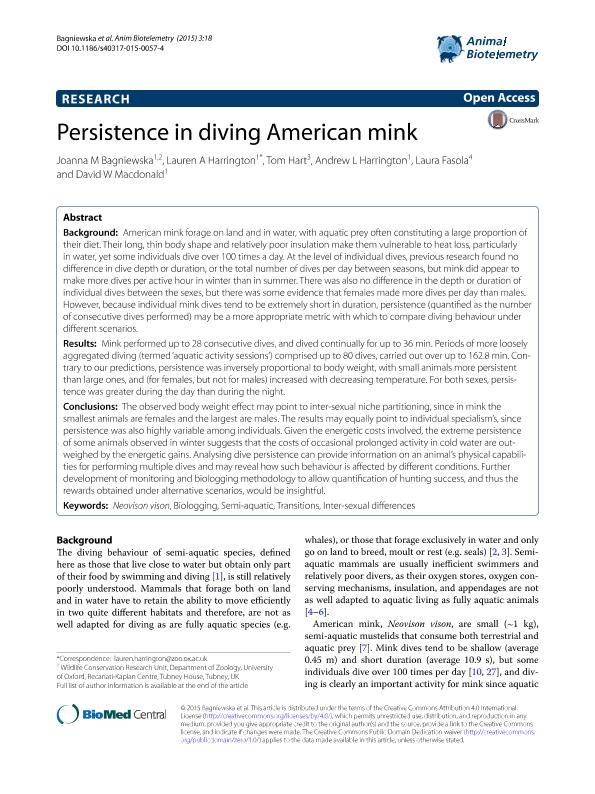Artículo
Persistence in diving American mink
Bagniewska, Joanna M.; Harrington, Lauren A.; Hart, Tom; Harrington, Andrew L.; Fasola, Laura ; Macdonald, David W.
; Macdonald, David W.
 ; Macdonald, David W.
; Macdonald, David W.
Fecha de publicación:
08/2015
Editorial:
Springer
Revista:
Animal Biotelemetry
ISSN:
2050-3385
Idioma:
Inglés
Tipo de recurso:
Artículo publicado
Clasificación temática:
Resumen
Background: American mink forage on land and in water, with aquatic prey often constituting a large proportion of their diet. Their long, thin body shape and relatively poor insulation make them vulnerable to heat loss, particularly in water, yet some individuals dive over 100 times a day. At the level of individual dives, previous research found no difference in dive depth or duration, or the total number of dives per day between seasons, but mink did appear to make more dives per active hour in winter than in summer. There was also no difference in the depth or duration of individual dives between the sexes, but there was some evidence that females made more dives per day than males. However, because individual mink dives tend to be extremely short in duration, persistence (quantified as the number of consecutive dives performed) may be a more appropriate metric with which to compare diving behaviour under different scenarios.
Results: Mink performed up to 28 consecutive dives, and dived continually for up to 36 min. Periods of more loosely aggregated diving (termed ‘aquatic activity sessions’) comprised up to 80 dives, carried out over up to 162.8 min. Contrary to our predictions, persistence was inversely proportional to body weight, with small animals more persistent than large ones, and (for females, but not for males) increased with decreasing temperature. For both sexes, persistence was greater during the day than during the night.
Conclusions: The observed body weight effect may point to inter-sexual niche partitioning, since in mink the smallest animals are females and the largest are males. The results may equally point to individual specialism’s, since persistence was also highly variable among individuals. Given the energetic costs involved, the extreme persistence of some animals observed in winter suggests that the costs of occasional prolonged activity in cold water are outweighed by the energetic gains. Analysing dive persistence can provide information on an animal’s physical capabilities for performing multiple dives and may reveal how such behaviour is affected by different conditions. Further development of monitoring and biologging methodology to allow quantification of hunting success, and thus the rewards obtained under alternative scenarios, would be insightful.
Palabras clave:
Neovison Vison
,
Biologging
,
Semi-Aquatic
,
Inter-Sexual Differences
Archivos asociados
Licencia
Identificadores
Colecciones
Articulos(CADIC)
Articulos de CENTRO AUSTRAL DE INVESTIGACIONES CIENTIFICAS
Articulos de CENTRO AUSTRAL DE INVESTIGACIONES CIENTIFICAS
Citación
Bagniewska, Joanna M.; Harrington, Lauren A.; Hart, Tom; Harrington, Andrew L.; Fasola, Laura; et al.; Persistence in diving American mink; Springer; Animal Biotelemetry; 3; 18; 8-2015; 1-10
Compartir
Altmétricas



